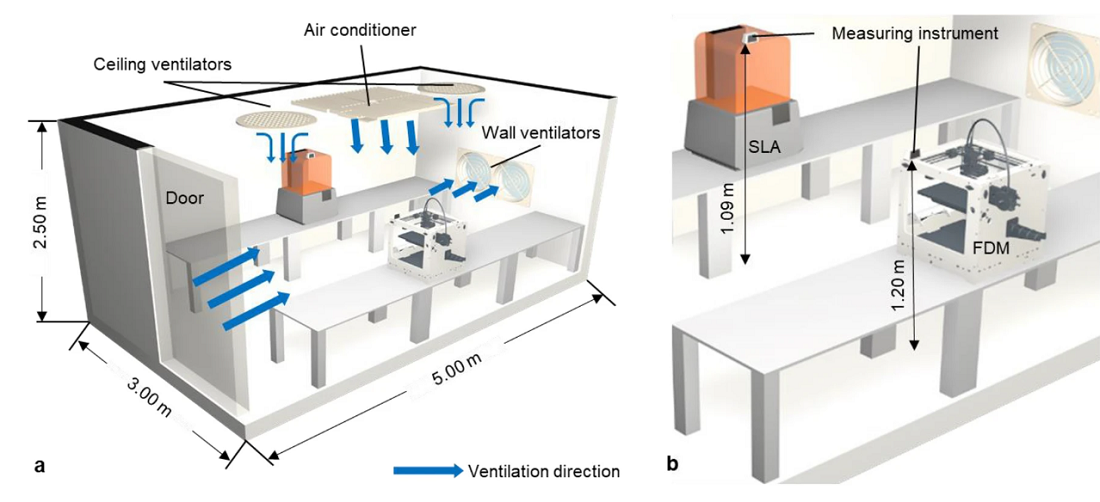We’re starting with research in 3D Printing News Briefs, as Embry-Riddle Aeronautical University researchers were awarded a grant from the National Science Foundation to enable smart 3D manufacturing, and a team of researchers from Korea measured the amount of some hazardous materials emitted into the air during 3D printing. On to construction, a city in Iowa is partnering with local housing organizations, nonprofits, a community college, and Alquist 3D to print 10 homes this year. Finally, a coffee supplier is exploring the use of metal 3D printed spare parts.
Embry-Riddle Researchers Receive NSF Grant

Dr. Daewon Kim, professor of Aerospace Engineering (middle), works with Nicholas Reed, Rishikesh Srinivasaraghavan Govindarajan, and Taylor Stark in Embry-Riddle’s SMART Lab. (Photos: Embry-Riddle/Daryl LaBello)
A team of three researchers from the Embry-Riddle Aeronautical University Daytona Beach campus were awarded a $500,000 seed grant from the National Science Foundation (NSF) to study a smart manufacturing approach that could help factories lower waste and create lighter energy-saving products for aerospace. The research is focused on providing real-time assessment of products during additive manufacturing by embedding wireless sensors into the products while they’re being manufactured; then, artificial intelligence and machine learning will be used to detect any defects and investigate the overall quality of the product. The research could majorly advance AM, and the grant will help the team investigate the viability of their approach, as well as support training and educational opportunities in new manufacturing approaches.
“I hope I can say it will revolutionize additive manufacturing because we will be able to monitor the printed products in real-time. The proposed work will also address a long-established idea that AM parts are unreliable or that they may have undetected defects, which has slowed down the adoption of AM in many industries,” said Dr. Daewon Kim, professor of Aerospace Engineering and leader of the team.
Evaluating the Effects of 3D Printer Ventilation on Formaldehyde & PM

The 3D printing (3DP) workspace with ventilation facility. (a) The layout of the 3DP workspace. (b) The location of measurement.
3D printing has been around for many years now, but hazardous materials, such as volatile organic compounds (VOCs), formaldehyde, and particulate matter (PM), are still released during the process, which can cause air pollution and negative impacts on the human body. In a new study, researchers from the University of Ulsan in Korea decided to measure some of these materials, namely formaldehyde and PM10, and PM2.5, that are emitted into the air when a ventilation operation is set up around the workspace. They tested six materials in material extrusion and vat photopolymerization methods, and compared them between the workspace and the control setting with test-retest validation. Unsurprisingly, the team recommends the use of ventilation systems while 3D printing.
“The experiments were divided into four stages based on the 3DP and ventilation operation. A linear mixed model was used to analyze the mean differences and tendencies between the 3DP workspace and the control setting. The change as ventilation was switched from off to on was evaluated by calculating the area. The differences and tendencies were shown in the statistically significant differences from a post-hoc test (α = 0.0125) except for some cases. There was a significant difference in formaldehyde depending on the ventilation operation; however, only a minor difference in PM10, and PM2.5 was confirmed. The amount of formaldehyde exceeding the standard was measured in all materials during 3DP without ventilation.”
10 3D Printed Houses to be Built in Muscatine, Iowa
The city of Muscatine, Iowa is working with local nonprofit and housing organizations, Muscatine Community College (MCC), and Iowa City additive construction company Alquist 3D to 3D print 10 homes there this year. This will be one of the first locations in the state to have 3D printed homes, and city leaders hope the project will help solve the county’s affordable housing crisis. Additionally, MCC students will be able to take a 3D printing course and even invited to help work on the homes, gaining important hands-on technical experience that will prepare them to join the future workforce.
Alquist 3D says it will take between 18 and 25 hours to print the walls of a house, using a giant robotic arm, and that 3D printing the framing is a cheaper, faster option that requires less manpower. The company says using 3D printing reduces labor costs up to 80%, and that construction on each of the houses will cost about $50,000 less than traditionally built homes. Home energy costs, as well as the upfront cost of the home ownership, may also be reduced thanks to the technology. Once the 10 3D printed homes are complete, which should be by the end of 2023, they will be marketed to families currently renting in the city, as well as educators in the school district. Construction is expected to begin this spring.
Bentax Investigating Metal 3D Printed Spare Parts for Milk Pumps
Coffee supplier Bentax found that two metal parts of its milk pump wear out quickly, but spare parts are not available, so each time this happens, the company has to purchase a brand new pump, instead of fixing the existing one. Bentax collaborated with the Danish Technological Institute (DTI) for the MADE Material Demonstration project to see if it could 3D print the critical spare parts and give new life to its pumps. The 10% of the milk pump that wears out quickly involves a few gears and a small housing, but the gears eventually cut into the housing and make tracks, which means the pump can’t operate properly. The whole pump was scanned and measured at the DTI, which made a digital copy, 3D printed the housing in stainless steel, and post-processed it down to the desired tolerances. The gears were manufactured in a PEEK material on a traditional CNC milling machine. The team ended up creating three test versions, and the components must be treated long-term with chromium nitride to keep the gears from breaking the surface. But Bentax and DTI believe this will increase the longevity and durability of the spare parts, and the partners are also satisfied with the price.
“We see many more possibilities now, also beyond the parts we put into the machines,” Anders Myrup, Technical Project Manager at Bentax, said about the technology. “It could be specially designed tools or adapted holders and hooks for the work tables in the workshop, so that we can optimize our processes – and this is derived from this project. I think that when we have to develop our inventory and digitize it further, it will also be 3D printing that will form the basis.”
Subscribe to Our Email Newsletter
Stay up-to-date on all the latest news from the 3D printing industry and receive information and offers from third party vendors.
You May Also Like
3D Printing News Briefs, April 13, 2024: Robotics, Orthotics, & Hypersonics
In 3D Printing News Briefs today, we’re focusing first on robotics, as Carnegie Mellon University’s new Robotics Innovation Center will house several community outreach programs, and Ugogo3D is now working...
Rail Giant Alstom Saves $15M with 3D Printing Automation Software 3D Spark
3D Spark has entered into a three-year deal with the rail giant Alstom. Alstom, a transport behemoth with annual revenues of $16 billion, specializes in the manufacture of trains, trams,...
Meltio Expands Global Reach with New Partnerships in the Americas and Europe
Spanish 3D printing manufacturer Meltio has expanded its sales network across the globe. With the addition of three new partners in the United States, Brazil, Argentina, and Italy, Meltio aims...
3D Printing Webinar and Event Roundup: April 7, 2024
Webinars and events in the 3D printing industry are picking back up this week! Sea-Air-Space is coming to Maryland, and SAE International is sponsoring a 3D Systems webinar about 3D...

































